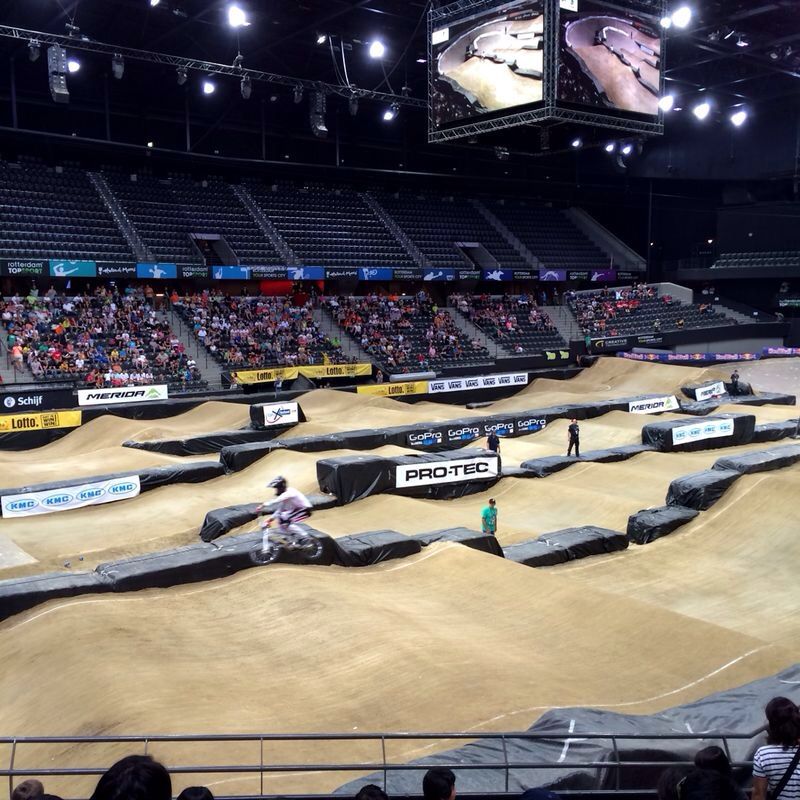Originally posted by rainman
View Post
Hoor ik daar upright rows

Leesvoer:
Your question: I read somewhere that pointing your toes out on leg extensions better hits the inner quads and that pointing your toes in better hits the outer quads. Yet on an online message board, a competitive bodybuilder said that turning the feet in or out on leg extensions is a waste of time. Which is correct?
The background: The leg muscles of the quads and hamstrings are composed of several muscles that work together to extend and flex the legs. While you cannot solely isolate one area of the quads or hams by altering the way you perform an exercise, such as the way you turn your feet (toes pointed in or out), you can place more emphasis on a certain area of the muscle.
The quads are made up of four muscles that originate on different parts of the femur (thigh bone) and hips but converge on one common tendon that crosses the front of the knee, and they work together to extend the leg at the knee joint. These muscles include the vastus lateralis (outer quad), the vastus medialis (the teardrop-shaped muscle just above the inside of the knee), the rectus femoris (middle quad muscle on the front of the thigh) and the vastus intermedius (middle quad muscle under the rectus femoris). Before exercise scientists conducted bodybuilding research, some pioneer bodybuilders were smart enough to note that if they turned their feet out about 45 degrees while doing leg extensions, they felt it more in the medialis, and if they turned their feet in about 30 degrees, they felt it more in the lateralis.
The hamstrings are composed of three muscles that originate on the hipbone and cross the back of the knee - the biceps femoris (outer hams), semimembranosus and semitendinosus (which collectively make up the inner hams). Opposite of the quads, some bodybuilders found that turning their feet out during leg curls better worked the outer hams, while turning their feet in better hit the inner hams.
Despite these discoveries, many scientists scoffed at the idea, saying it’s impossible to place greater emphasis on one area of the thigh muscles over the others. So who’s right?
The research: Some of the earliest research on the effect of turning the feet in or out on leg exercises was performed by pioneering exercise scientist Dr. Per Tesch in the 1990s and published in his book Target Bodybuilding (Human Kinetics, 1999). He used MRI (magnetic resonance imaging) technology to capture images of the muscles being exercised in toes-out and toes-in positions. He noted, as the aforementioned bodybuilders did, that turning the toes in utilized more of the vastus lateralis and turning the toes out utilized the vastus medialis to a greater degree.
On leg curls, he found similar results to what the bodybuilders reported - the “toes-out” position utilized more of the outer hams and the “toes-in” position used more inner hams. In addition, new research published in a 2008 issue of the Journal of Electromyography & Kinesiology by researchers from Queens University at Kingston (Ontario, Canada) supports Tesch’s reports regarding foot position and hamstring muscle emphasis during training using EMG (electromyography) technology.
The Canadian researchers had test subjects perform the leg curl with their feet turned in, turned out and straight ahead while the amount of muscle activity in the inner and outer hams was measured using EMG. The scientists found that turning the feet in on the leg curl, as well as other exercises, significantly stressed the inner hamstring, while turning the feet out had the opposite effect: greater emphasis on the outer ham.
Turning point: Results show a 140% increase in muscle activity of the inner hams when the toes were pointed in and a 70% increase in muscle activity of the outer hams when the toes were pointed out.
For discussion: With two different technologies (MRI and EMG) supporting the notion that turning your feet in or out can change muscular emphasis during leg extensions and leg curls, it’s hard to argue that the technique doesn’t work. Anyone who still claims it doesn’t is simply misinformed. The bottom line is that turning your feet out on leg extensions hits more of the medialis, while turning them in hits more of the lateralis. For leg curls, it’s unequivocal that turning your feet out hits more of the outer hams and turning your feet in hits more of the inner hams.
Final thought: Whether you have well-balanced thighs or thighs that need to be brought up in certain areas, turning your feet can be used to your advantage. Let’s say you have weak teardrops (medialis). When you do leg extensions, first warm up with your feet straight, then do two working sets with your toes pointed out, and finish with 1-2 sets with your toes back to the straight-up position.
If you have well-balanced thighs, you can change the way you do your exercises every workout or every set. For example, on lying leg curls you can turn your feet in to better overload the semitendinosus and semimembranosus (inner hams) in one workout, then turn your toes out to better overload the biceps femoris (outer hams) in the next, then keep your feet straight in the third workout to evenly overload all three hamstring muscles. You could even change positions on each set.






Comment